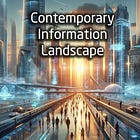Preface
Trust in digital environments has become a critical area of study, bridging Computer Science and Information Science. This essay examines the multifaceted nature of trust in an increasingly connected world, exploring how technological advancements shape interactions and perceptions of reliability. This work investigates factors influencing online trust, from encryption algorithms to human-computer interaction principles, aiming to provide a foundational framework for data and analytics professionals. However, this complex topic is approached with much humility, recognizing the understanding of digital trust is continually evolving. This exploration is a continuation of the current conversation, acknowledging each area deserves deeper examination. As technology advances, there is always more to discover in this field.
Trust has become a critical factor in our interactions with technology. This essay examines the multifaceted nature of trust in the digital age through the disciplines of Computer Science and Information Science, drawing insights from communication technology, digital security, information literacy, and contemporary media studies.
Trust in technology-mediated communication systems1 is fundamentally shaped by the technical aspects of digital channels. Video calls utilize high-speed internet connections and sophisticated compression algorithms to transmit complex audiovisual data. This technology enables the communication of important non-verbal signals, which play a vital role in establishing trust between participants. A real-world application of this is telemedicine, where high-quality video communication is essential for building patient-doctor trust in remote consultations.
As our interactions increasingly occur online, novel computational approaches to trust have emerged. E-commerce platforms employ reputation systems using algorithms to aggregate user feedback and calculate trust scores, facilitating transactions between unfamiliar parties. These systems often utilize graph-based algorithms to model trust relationships, identifying and isolating malicious actors within the network. This algorithmic approach to trust extends beyond e-commerce, influencing social media interactions and online communities.
In designing these digital interfaces, Human-Computer Interaction (HCI) principles play a crucial role in fostering trust. Techniques like progressive disclosure, which presents complex information incrementally, enhance user comprehension and trust. Social media platforms often implement this approach for privacy settings, gradually introducing users to more advanced options as they engage with the system. This user-centric design philosophy is essential in creating digital environments where users feel confident and in control.
Underlying these user-facing systems, digital security2 forms the bedrock of trust in online interactions. Encryption algorithms such as AES (Advanced Encryption Standard) and RSA (Rivest–Shamir–Adleman) are fundamental to secure digital communications. AES, a symmetric-key algorithm, employs substitution and permutation operations to encrypt data. RSA, an asymmetric algorithm, relies on the computational complexity of factoring large prime numbers for secure key exchange and digital signatures. These cryptographic techniques ensure the confidentiality and integrity of digital communications, essential components of online trust.
Blockchain technology offers an innovative approach to building trust in decentralized systems. Its consensus mechanisms, like Proof of Work or Proof of Stake, enable untrusting parties to agree on a shared ledger's state without central authority. This technology is being applied beyond cryptocurrencies, finding applications in supply chain management to create transparent, tamper-proof records of product origins and movements. By providing a decentralized and immutable record, blockchain has the potential to transform how we establish and maintain trust in various digital transactions.
As we look to the future, quantum computing presents significant challenges to current cryptographic systems. Shor's algorithm, capable of efficiently factoring large numbers on quantum computers, threatens RSA encryption security. This has prompted research into post-quantum cryptography, developing algorithms resistant to both classical and quantum attacks. Lattice-based cryptography is being explored as a potential quantum-resistant alternative, highlighting the ongoing evolution of digital security measures.
In the realm of cybersecurity, Artificial Intelligence and machine learning are increasingly utilized. Anomaly detection algorithms can identify unusual patterns in network traffic, potentially indicating security breaches. Credit card companies employ these techniques to detect fraudulent transactions in real-time, demonstrating the practical application of AI in maintaining trust in financial systems.
Shifting focus to information science3, trust is intrinsically linked to information credibility and accessibility. Information retrieval systems are crucial in this context, determining user-encountered information and its presentation. Advanced retrieval models, including those based on latent semantic analysis or neural networks, aim to better interpret user intent and deliver more relevant, trustworthy results. These systems play a vital role in shaping our digital information landscape and, consequently, our trust in online information sources.
Data mining techniques are being applied to analyze trust dynamics in digital environments. Sentiment analysis algorithms can assess public trust in institutions or technologies by processing vast social media data volumes. This approach has been utilized to gauge public sentiment towards COVID-19 vaccines, informing public health communication strategies and demonstrating the power of data analysis in understanding and influencing public trust.
Knowledge management systems are evolving to enhance information credibility assessment. These systems increasingly incorporate features like provenance tracking, documenting information origin and transformation history, enabling users to evaluate trustworthiness. This is particularly vital in scientific research, where data lineage traceability is essential for reproducibility and trust in findings.
Information visualization techniques offer powerful tools for fostering trust in complex data environments. Interactive visualizations can enhance algorithmic decision transparency, allowing users to explore how various factors influence outcomes. Some credit scoring systems now provide interactive tools demonstrating how different financial behaviors impact credit scores, increasing user trust and comprehension.
The contemporary information landscape4 presents unique trust challenges. Echo chambers and filter bubbles, exacerbated by recommendation algorithms, can be conceptualized as a form of information isolation in network terms. Addressing this requires developing algorithms that balance personalization with diversity, potentially drawing on information theory concepts to maximize recommended content's information gain.
Deepfake technology poses a significant threat to trust in visual information. Current detection methods often employ convolutional neural networks to identify artifacts or inconsistencies in manipulated videos. However, as generation techniques improve, detection becomes increasingly challenging, necessitating continuous advancements in this field.
Algorithmic transparency presents both technical and ethical challenges. Explainable AI (XAI) techniques aim to make complex machine learning models more interpretable, potentially increasing user trust. LIME (Local Interpretable Model-agnostic Explanations) and SHAP (SHapley Additive exPlanations) are methods providing insights into AI decision-making processes, crucial for applications in healthcare, finance, and criminal justice.
Emerging technologies like brain-computer interfaces will likely introduce new trust paradigms. These systems, directly interfacing with neural activity, will require robust security measures and raise novel questions about data privacy and user autonomy. Developing these technologies necessitates close collaboration between neuroscientists, computer scientists, and ethicists.
Addressing digital trust issues requires interdisciplinary collaboration. Psychological insights, such as theories of social proof or cognitive biases, inform the design of more trustworthy systems. Understanding phishing attack psychology aids in developing more effective cybersecurity training programs. Sociological perspectives on group dynamics enhance our understanding of trust in online communities, influencing social media platform design. Anthropological approaches illuminate how cultural factors influence technology trust across societies, crucial for developing globally accessible and trustworthy systems.
Computer Science and Information Science play central roles in addressing digital trust issues. From developing secure communication protocols to creating transparent AI systems, technical solutions are necessary for building and maintaining trust in our increasingly digital world. However, these solutions must be informed by social science insights and guided by ethical considerations. As technology evolves, so too must our approaches to fostering digital trust. The future of digital trust lies in continued innovation, interdisciplinary collaboration, and commitment to creating technologies that are not just powerful, but also trustworthy and human-centered.






